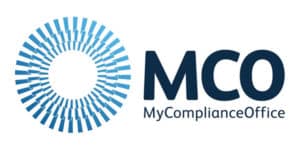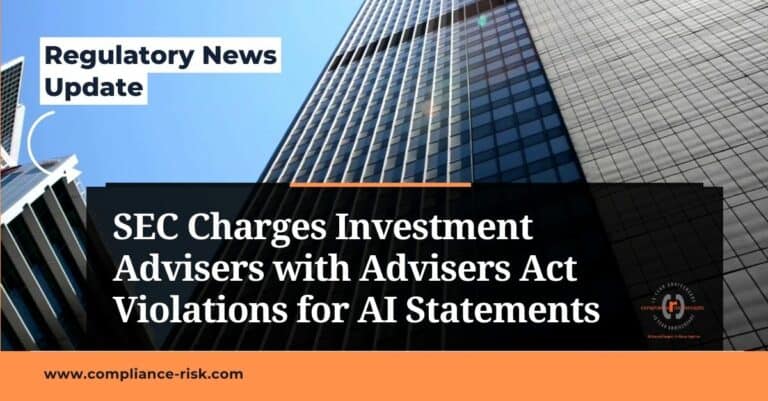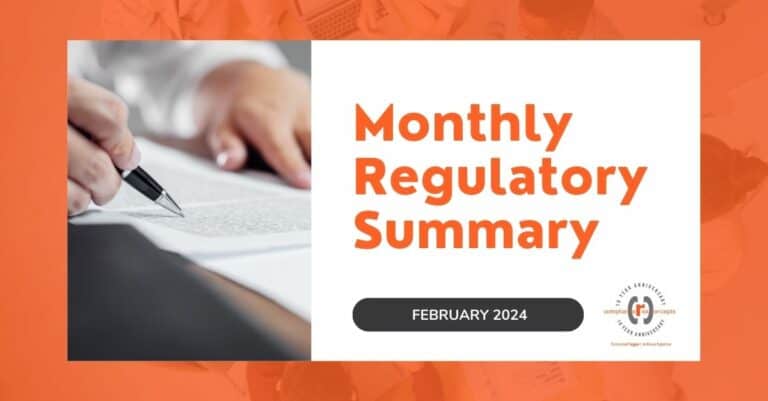Monthly Regulatory Summary
As the regulatory landscape is constantly evolving, Compliance Risk Concepts (“CRC”) is issuing its monthly review and summary of FINRA, SEC, and NFA notices and bulletins to assist our clients in keeping abreast of notable regulatory developments and deadlines in an effort to strengthen their compliance and regulatory initiatives.
FINRA
Regulatory Notices
Per Notice 21-35, FINRA requests comment on a proposal to require members to publish quarterly order routing disclosure reports for held orders in OTC Equity Securities. The proposed new quarterly reports would be similar to those required for NMS stocks under the Securities and Exchange Commission’s (SEC) Rule 606(a) of Regulation NMS, with certain modifications reflecting the different structure of the OTC market. FINRA also requests input on possible steps to further facilitate investor access and understanding of current order routing disclosures for NMS securities.
FINRA encourages all interested parties to comment on this proposal. Comments must be received by December 6, 2021.
Per Notice 21-36, the Financial Crimes Enforcement Network (FinCEN) has issued the first government-wide priorities for anti-money laundering and countering the financing of terrorism policy, which was mandated by the Anti-Money Laundering Act of 2020 (AML Act). FinCEN also issued a statement to provide covered non-bank financial institutions (NBFIs), including broker-dealers, with guidance on how to approach the AML/CFT Priorities.
FINRA is issuing this Notice to inform member firms of the AML/CFT Priorities and the Statement, and to encourage member firms to consider how to incorporate the AML/CFT Priorities into their risk-based anti-money laundering (AML) compliance programs.
FinCEN has clarified that the publication of the AML/CFT Priorities does not create an immediate change in the BSA requirements or supervisory expectations for covered NBFIs, including broker-dealers. FinCEN has noted further that covered NBFIs are not required to incorporate the AML/CFT Priorities into their risk-based AML programs until the effective date of final regulations promulgated by it. The BSA, as amended by the AML Act, requires that FinCEN promulgate any appropriate regulations regarding the AML/CFT Priorities within 180 days of their establishment.
FinCEN has stated that the final regulations will specify how financial institutions should incorporate the AML/CFT Priorities into their risk-based AML programs, and that not every priority will be relevant to every covered institution. FinCEN has also stated that covered NBFIs may nevertheless wish to start considering how they will incorporate the AML/CFT Priorities into their risk-based AML programs, such as by assessing the potential risks associated with the products and services they offer, the customers they serve, and the geographic areas in which they operate.
Per Notice 21-37, the NAC has revised FINRA’s Sanction Guidelines to incorporate a new guideline for violations of the Consolidated Audit Trail System (CAT) industry member compliance rules.
The revised Sanction Guidelines are effective immediately and available on FINRA’s website.
Per Notice 21-38, on November 8, 2021, FINRA will cease operation of the OTC Bulletin Board (OTCBB)—a FINRA-operated inter-dealer quotation system—and delete the OTCBB-related rules from the FINRA rulebook.
Per Notice 21-39, FINRA’s Renewal Program supports the collection and disbursement of fees related to the renewal of broker-dealer (BD) and investment adviser (IA) registrations, exempt reporting and notice filings with participating self-regulatory organizations (SRO) and jurisdictions. FINRA communicates information about renewal fees BD and IA firms owe via a Preliminary Statement in November, and publishes a Final Statement in January to confirm or reconcile the actual renewal fees BD and IA firms owe after Jan. 1, 2022. Renewal statements reflect all applicable renewal fees assessed for BD and IA firms, branches and individuals.
It is critical that firms ensure that they pay in full by the Preliminary Statement deadline. If payment is late, firms should ensure that the Preliminary Statement is paid in full before the year-end system shutdown. Payments received after the Preliminary Statement deadline for FINRA-registered firms are subject to a late fee.
Firms should note that, as announced in SR-FINRA-2020-032, FINRA’s Branch Office Processing fee, which includes the branch renewal processing fee, will increase from $20 to $75 on Jan. 1, 2022. This new fee amount will affect 2022 renewal fees assessed for branches registered with FINRA. See the Renewal Fees & Payment Methods section in the Notice for additional information.
Special Notices
There were no Special Notices in October.
SEC
Final Rules
Per Release No. 33-10997, the SEC (or “Commission”) is adopting amendments that will modernize filing fee disclosure and payment methods. The Commission is amending most fee-bearing forms, schedules, statements, and related rules to require each filing fee table and accompanying disclosure to include all required information for fee calculation in a structured format. The amendments will add options for fee payment via Automated Clearing House (“ACH”) and debit and credit cards, and eliminate options for fee payment via paper checks and money orders. The amendments are intended to improve filing fee preparation and payment processing by facilitating both enhanced validation through filing fee structuring and lower-cost, easily routable payments through the ACH and debit and credit card payment options. Finally, the Commission is adopting other amendments to enhance the efficiency of the fee process.
Proposed Rules
Per Release No. 33-10998, the SEC (or “Commission”) is reopening the comment period for its proposal to implement the provisions of Section 954 of the Dodd-Frank Wall Street Reform and Consumer Protection Act of 2010 (“Dodd-Frank Act”). The proposed rule and rule amendments would direct the national securities exchanges and national securities associations to establish listing standards that would require each issuer to develop and implement a policy providing for the recovery, under certain circumstances, of incentive-based compensation based on financial information required to be reported under the securities laws that is received by current or former executive officers, and require disclosure of the policy (the “Proposed Rules”). The Proposed Rules were set forth in a release published in the Federal Register on July 14, 2015 (Release No. 34-75342) (the “Proposing Release”), and the related comment period ended on September 14, 2015. The reopening of this comment period is intended to allow interested persons further opportunity to analyze and comment upon the Proposed Rules in light of developments since the publication of the Proposing Release and the Commission’s further consideration of the Section 954 mandate.
Interim Final Rules
There were no interim final rules in October.
Interpretive Releases
There were no interpretive releases in October.
Policy Statements
There were no policy statements in October.
NFA
Notices to Members
Per Notice I-21-33:
NFA has received a number of requests from swap dealers (SD) to extend NFA's approval of its IM model to include security-based swaps (SBS) in initial margin (IM) calculations on a net portfolio basis. NFA will extend its IM Model approval to include SBS under the conditions outlined below.
Starting November 1, 2021, SDs may include SBS in IM model calculations on a net portfolio basis subject to the following three conditions:
- The SD notifies NFA in writing via email at SwapsMarginModel@nfa.futures.org that it meets the requirements outlined in CFTC No Action Letter 16-71 (PDF download) or the SEC Margin Rules (PDF) and intends both to post and collect margin on a net portfolio basis for swaps and SBS and include SBS in the IM Model calculation;
- The SD's Model Risk Management (MRM) team has issued either an approval, a preliminary positive opinion, or a waiver on the inclusion of SBS in the IM model, which may include establishing effective compensating controls or an enhanced monitoring framework to ensure the conservativeness of the IM calculated on a net portfolio basis using an IM Model; and
- If the SD's MRM team authorizes the inclusion of SBS in IM portfolios via waiver, the MRM team must establish, and the SD must communicate to NFA, the timeframe (no longer than six months after its implementation in production) for conducting its in-depth review of the product types introduced in the IM model.
To ensure SBS exposure is properly treated when calculating IM using an IM model, the SD's MRM team must adequately validate the inclusion of SBS exposure in the SD's portfolios. As part of its validation activities, the MRM team must, at a minimum:
- Identify the products to be added and the expected volumes;
- Assess the model assumptions and limitations specifically relating to SBS and on a net portfolio basis;
- Complete an impact analysis on the compositions and risk profiles of the existing portfolios due to the introduction of SBS;
- Perform an assessment of material proxies and approximations introduced by SBS into the IM model framework, including remediation and compensating controls for material proxies and approximations; and
- Assess testing results for SBS at the product level as well as the overall impact of the introduction of SBS on the quarterly model performance testing results of the current portfolios approved to be margined on the IM model. The assessment must cover, at a minimum:
- Backtesting (covering a minimum period of three months);
- Benchmarking to relevant internal and external data sources or estimation techniques (including a corporate risk measure integrated into the SD's risk management systems, such as corporate VaR, and observable margin standards such as a derivatives' clearing organization); and
- Risks not in the IM model.
In order to ensure the conservativeness of IM model calculations, the MRM team must also assess whether compensating controls, thresholds and/or an enhanced monitoring framework should be added. Any compensating controls previously established should also be reviewed by the MRM team.
NFA will review each SD's implementation of SBS in its IM model at a later date, which will focus on the MRM team's validation activities.
News Releases
October 28, 2021
NFA orders London, U.K. introducing broker Freight Investor Services Limited to pay a $140,000 fine
October 28, Chicago—NFA has ordered Freight Investor Services Limited (Freight), an NFA Member introducing broker located in London, U.K., to pay a $140,000 fine.
The Decision, issued by NFA's Business Conduct Committee (BCC), is based on a Complaint issued by the BCC and a settlement offer submitted by Freight, in which it neither admitted nor denied the allegations. The Committee found that Freight failed to keep full, complete and systematic records of all transactions relating to Freight's business of dealing in commodity interests. The Committee also found that Freight allowed an unregistered individual to act as an associated person without being registered in such capacity and an NFA Associate.
The complete text of the Complaint and Decision can be viewed on NFA's website.
Hot Issues
CyberCrime
Cybercrime is constantly developing. With attacks becoming more prevalent and sophisticated. Now is the time to perform a cybersecurity check for your firm to ensure not only compliance with industry standards, but confirm the firm’s ability to prevent, detect, and respond to evolving cyber threats. Prevention begins with training; make certain that in addition to proper security measures, applicable personnel has been rigorously trained with respect to information and technology security measures.
Regulatory Exam Preparedness
Regulators have been out in force throughout the pandemic and continue to do so. We have observed trends toward lengthy, deeper dive exams, conducted remotely. Firms should consider initiatives aimed at identifying and remediating regulatory gaps in their programs, particularly with respect to current exam focus area trends.
Our Perspective
Regulators continue to demonstrate their commitment to protecting investors by aggressively pursuing bad actors and reviewing and updating regulations to guard investors against constantly evolving threats.
The best approach to regulatory compliance is a proactive one. Staying ahead of the curve by taking note of statements and guidance released by regulators and using them as a barometer to assess the current regulatory climate can help ensure that a firm is prepared for a regulatory exam. Rather than scrambling to rectify issues or meet deadlines, a thorough, active compliance program that considers and incorporates regulatory developments is in a better position to satisfy regulators and preserve operations so they can best serve their clients.
For more information, please contact:
Mitch Avnet
p. (646) 346-2468
mavnet@compliance-risk.com
David Amster
p. (917) 568-6470
damster@compliance-risk.com
Sources:
- FINRA October 2021 Industry Notices
- SEC Regulatory Actions
- NFA Notices
- NFA Press Releases













